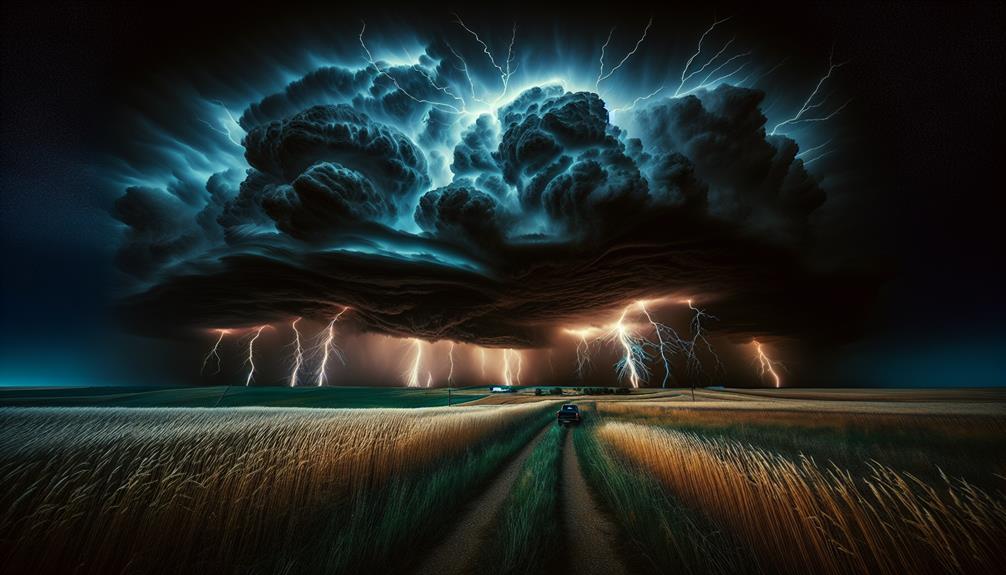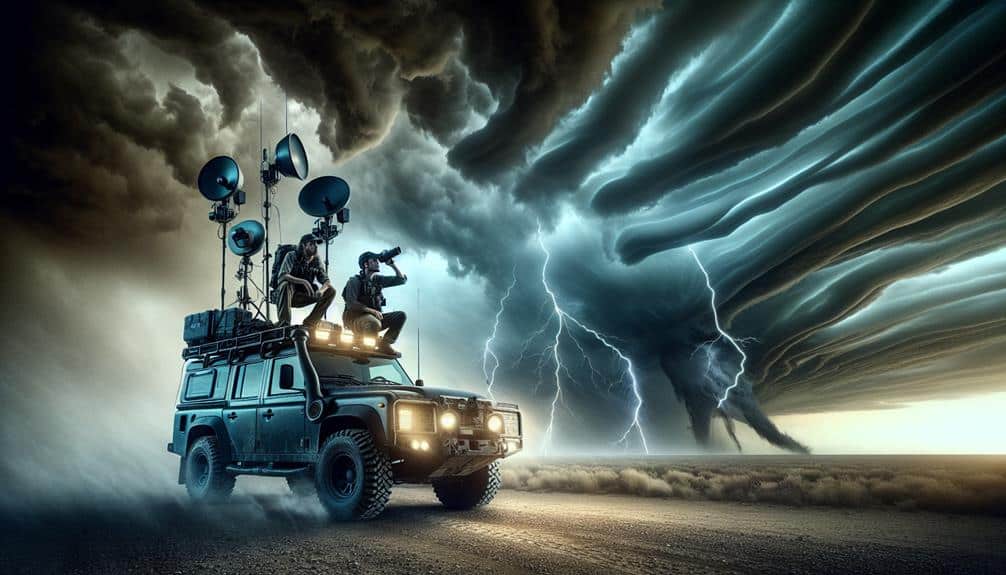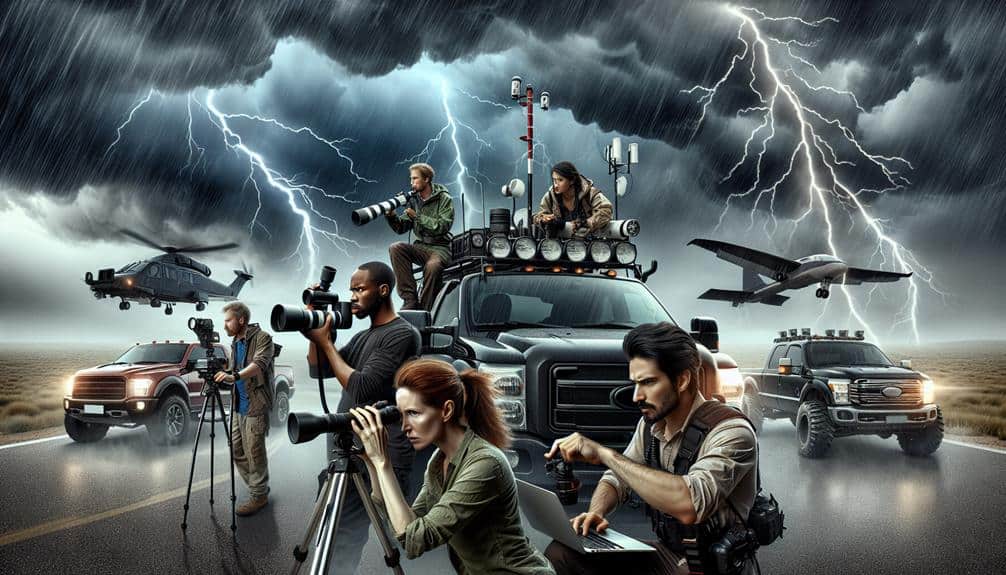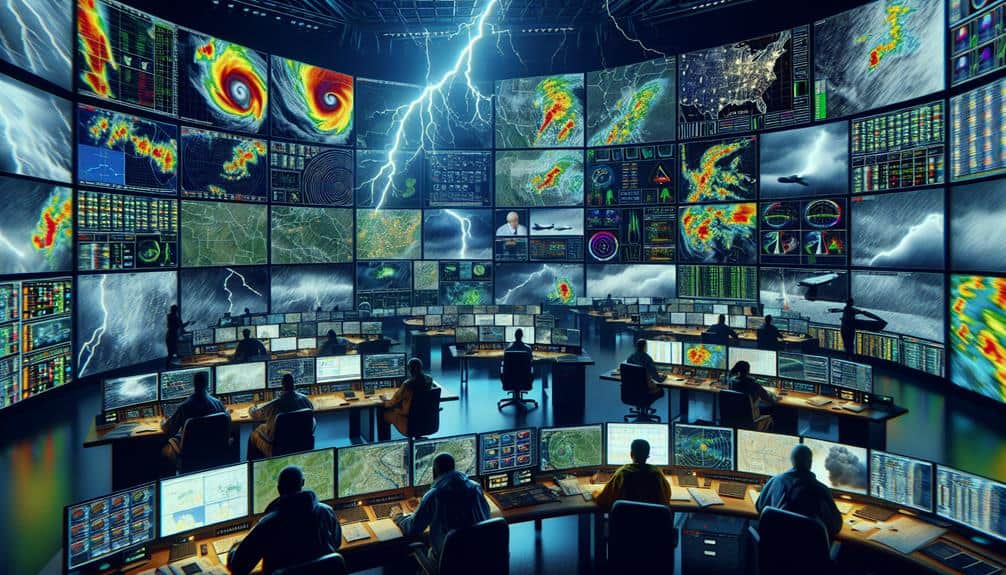As storm chasers, we target hotspots like Tornado Alley, Dixie Alley, the Great Plains, the Florida Coast, and the Midwest for electrifying experiences and valuable data collection. Tornado Alley offers frequent supercell thunderstorms due to air convergence, while Dixie Alley challenges us with nocturnal tornadoes and tricky terrain. The Great Plains' vast openness provides excellent visibility for tracking supercells, and the Florida Coast's warm waters breed powerful tropical cyclones. Finally, Midwest thunderstorms are intense and lightning-rich. Each region presents unique meteorological phenomena and requires specialized tactics. For those intrigued, there's more to uncover about these thrilling locales.
Key Points
- Tornado Alley: Central US region with frequent tornadoes due to converging warm and cold air masses.
- Dixie Alley: Southeastern US with challenging terrain and frequent nocturnal tornadoes requiring advanced night-vision equipment.
- Great Plains: Open landscapes ideal for spotting supercells and collecting meteorological data.
- Florida Coast: Prime location for tracking tropical cyclones and hurricanes with advanced technologies.
Tornado Alley
Tornado Alley, a region spanning parts of the central United States, is renowned for its high frequency of tornadoes due to the unique convergence of warm, moist air from the Gulf of Mexico and cold, dry air from Canada. This collision creates the perfect conditions for supercell thunderstorms, which are the precursors to tornado formation. For us storm chasers, understanding these dynamics is essential.
When we venture into Tornado Alley, safety is our top priority. The right storm chasing equipment, such as Doppler radar, anemometers, and GPS, is necessary. These tools help us stay informed about changing weather conditions and potential tornado formation. Additionally, we always carry emergency kits and make sure our vehicles are in top condition.
Recognizing tornado warning signs is another crucial aspect of our expeditions. Wall clouds, funnel clouds, and sudden changes in wind direction or speed are all indicators that a tornado might be imminent. By staying vigilant and interpreting these signs accurately, we can position ourselves safely to observe these natural phenomena.
In Tornado Alley, the thrill of storm chasing is balanced with a commitment to safety and a deep respect for the power of nature.
Dixie Alley
While Tornado Alley often garners the most attention, Dixie Alley, stretching across the southeastern United States, presents its own unique storm chasing challenges and opportunities. Here, the terrain is more varied, featuring dense forests, rolling hills, and numerous water bodies. This geographical diversity complicates visibility and escape routes, making Dixie Alley safety an essential concern for storm chasers.
We need to employ specific storm chasing tactics tailored to this region. For instance, mobile radar units are invaluable for tracking storms obscured by the landscape. Additionally, having a well-thought-out navigation plan is crucial. The road networks here are less grid-like compared to the Great Plains, which means we must rely heavily on GPS technology and updated topographical maps.
Moreover, Dixie Alley frequently experiences nocturnal tornadoes, which are particularly dangerous due to reduced visibility and public awareness. To enhance Dixie Alley safety, it's important to utilize night-vision equipment and maintain constant communication with local meteorological stations. Real-time weather updates can provide critical information about storm trajectories and intensity.
Great Plains
In contrast to Dixie Alley, the Great Plains offer expansive, open landscapes that greatly enhance storm visibility and tracking accuracy. The vastness of this region, stretching from Texas through Nebraska and into the Dakotas, allows us to observe extreme weather phenomena with minimal obstructions. This unique geography is ideal for spotting supercells and tornadoes, which are frequent in this area due to the collision of warm, moist air from the Gulf of Mexico and cold, dry air from the Rockies.
This region provides an ideal setting for storm chasers equipped with chase vehicles loaded with advanced meteorological instruments. These vehicles are crucial for gathering real-time data, such as Doppler radar and anemometers, enabling safe navigation and efficient tracking of storms. The road networks in the Great Plains, primarily laid out in a grid pattern, further aid in strategic positioning and rapid relocation as storms evolve.
Data collected from these chases contribute significantly to our understanding of severe weather systems, enhancing prediction models and preparedness strategies. The combination of wide-open spaces in the Great Plains and cutting-edge technology makes this region a top choice for storm chasers seeking both adventure and scientific discovery.
Florida Coast
The Florida Coast presents a unique storm chasing environment where we frequently encounter tropical cyclones and hurricanes, providing invaluable opportunities to study these powerful systems up close.
With its extensive coastline, Florida offers excellent vantage points for beach watching, enabling us to monitor storm surges, wind speeds, and precipitation patterns with precision.
We rely on advanced hurricane tracking technologies, such as Doppler radar and satellite imagery, to predict storm paths and intensities accurately. These tools allow us to gather critical data on atmospheric pressure, wind speed, and moisture levels.
The Florida Coast's subtropical climate and warm waters create ideal conditions for hurricanes to develop and intensify, making it a hotspot for storm chasers seeking to understand these phenomena better.
In addition to the scientific benefits, the freedom to explore the dynamic coastline provides a thrilling experience. As we observe the interplay between the ocean and atmosphere, we gain a deeper appreciation for the raw power of nature.
This region's unique geography and meteorological conditions make it an essential location for anyone dedicated to hurricane tracking and beach watching. The Florida Coast continues to be a prime area for advancing our knowledge and honing our storm-chasing skills.
Midwest Thunderstorms

Amidst the vast plains of the Midwest, we often encounter some of the most intense and electrically active thunderstorms, offering important insights into severe weather dynamics. These thunderstorms are characterized by dramatic storm cloud formations and frequent lightning strikes, making the region ideal for lightning photography. Our experience teaches us that the Midwest's flat terrain provides unobstructed views, allowing us to capture stunning images of the storm's electrifying beauty.
While chasing these storms, we must prioritize severe weather safety. Implementing proper storm spotting techniques is critical. We use radar data and real-time weather updates to track storm development and movement. By maintaining a safe distance, we can observe the storm's behavior without putting ourselves in unnecessary danger. Understanding the lifecycle of a thunderstorm helps us anticipate potential hazards, such as hail, high winds, and tornadoes.
In the Midwest, the combination of powerful storms and expansive landscapes creates a unique environment for storm chasers. Our pursuit isn't just about the thrill; it's about gaining valuable knowledge and contributing to the field of meteorology. By following stringent safety protocols and utilizing advanced tracking methods, we maximize both our safety and the scientific value of our storm chasing expeditions.
Frequently Asked Questions
What Equipment Is Essential for Storm Chasing?
We rely on storm tracking technology, safety gear, and must-have equipment like weather radios, GPS, and cameras. Preparedness tips include packing first aid kits, emergency food, and ensuring our vehicle is fully fueled and maintained.
How Can I Stay Safe While Storm Chasing?
To stay safe while storm chasing, we must prioritize emergency preparedness and safety precautions. Conduct thorough risk assessments, maintain reliable communication strategies, and always have an exit plan. Freedom to chase comes with responsibility and vigilance.
Are There Any Legal Restrictions for Storm Chasers?
Are there legal implications for storm chasing? Indeed, we must navigate local laws carefully. Safety precautions are essential, and while freedom drives us, we can't ignore regulations that guarantee our storm chasing adventures remain within legal boundaries.
What Are the Best Apps for Tracking Storms in Real-Time?
We rely on top storm tracking apps like RadarScope and Storm Shield for their accuracy. They provide real-time alerts and notifications, ensuring we're always informed. These tools maximize our freedom to chase safely and effectively.
How Can I Join a Storm Chasing Tour or Group?
Dive into the eye of the storm by joining communities and networking. We need proper training and preparation to guarantee safety. Look for reputable storm chasing tours online, and connect with seasoned chasers through forums and social media.


